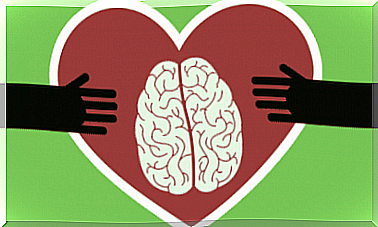Theory Of Relational Frameworks

The theory of relational frameworks is a theory about language and cognition. It serves as the experimental basis for Acceptance and Commitment Therapy (ACT). From the perspective of relational framework theory, behavior and language are intrinsically linked.
This framework provides a functional explanation of some conclusions drawn from cognitive research on language and serves as the basis for the monistic study of phenomena. It is a theory that aspires to study what are called “mental processes” in an operational and experimental way.
Theory of relational frameworks: concepts and properties
To understand what a relational framework is, it is necessary to know that the human being does not learn only from direct experiences. People also learn indirectly by relating stimuli beyond their physical properties. It is this linguistic added value of stimuli that would condition their ability to govern relationships and functions.

Properties of a relational framework
To link and transform, both cognition and language, there are three properties:
- Mutual Link: A relationship between two stimuli involves responding to one in terms of the other and vice versa. If, in a given context, A is directly related to B, then there is a derived relation between B and A
- Combinatorial Link: One of the defining characteristics of relational frameworks is the ability to combine events with one another. If A is characteristically related to B, and A is related to C, B and C would also be related
- Transformation of functions: In the case of a stimulus that has a function, if another stimulus establishes a relation with it in this context, the function of both is transformed by this relation. For example, if someone tells us that there is a better and cheaper product than the one we usually use, the likelihood that we will buy it increases. Its function has been transformed by the relationship that has been established
Types of contextual keys in relational framework theory
Mutual links, multiple link combinations and function transformations are components of a larger relational response model than relational framework theory (RFT) called “relational framework”. The concept is used to explain how we learn to make associations derived from the relationships between stimuli.
Relational frameworks can be combined to generate verbal rules governing behavior. This process allows people to organize, predict and control the realization of consequences according to the context. In this way, we can anticipate future situations without having experienced them.
Contextual keys to the theory of relational frameworks
Each learning context presents multiple stimuli. With the possibility of acquiring the value of the keys that govern the development of relational frameworks. The RFT distinguishes between two subtypes of contextual keys:
- Those which govern the type of relation specified (C rel ). The most notable types are coordination, opposition, distinction, comparison, spatial, temporal, causal, hierarchical and deictic
- As each stimulus or event can have several psychological functions. A second class of contextual keys (C func ) will specify which stimuli functions will be transformed (Torneke, 2010)
The theory of relational frameworks as an explanation of human suffering
In this theoretical framework, one could say that there are certain properties of language which make psychological suffering something very common. One of them would be, precisely, the capacity to believe literally what our thoughts, our emotions, our feelings indicate to us and to act according to their dictates.
So, if a person thinks of himself that he is “junk” and that he is “worthless”, that probably limits his attitude tremendously. That way we would see how many people are giving up on achievable goals. And this is because they think they are beyond their reach.
Types of verbal rules in relational framework theory
The theory of relational frameworks has taken this fact further, explaining the main types of verbal regulation (Luciano and Wilson, 2002):
- Compliance: in these types of rules, the consequences are obtained by complying with them and the consequences are applied by the person who generated the rule. These are behaviors that are largely determined by what the cultural context determines to be appropriate. For example, a mother says: “If you don’t eat, I will punish you”
- Tracking: these are verbally regulated behaviors that guide the human being to obtain concrete reinforcers in the context. They relate directly to the consequences obtained from the behavior. For example, “if you eat, you won’t be hungry anymore and you will feel better”. In this case, the consequences depend on the characteristics of the food and are independent of the person who stated the rule.
- Augmenting: This is a transformation of functions that determines that a verbal stimulus, object or event acquires reinforcement or aversion value. It is important to point out that they always work in combination with pliances and trackings
The augmenting is a verbal rule that changes the building of a stimulus property that functions as a consequence. That is, which increases or decreases the likelihood that the stimulus will influence behavior as a consequence.
For example, walking past an ice cream shop, someone says: “Ice cream would do us good!” When we hear or read this phrase, we smell the taste and freshness of ice cream to some extent, which increases the likelihood of eating it.
Behavioral patterns determined by verbal rules
Verbal regulation allows us to govern our behavior according to the context. But it can also have different negative effects :
- Strict compliance with the rules of Pliance means that the individual is insensitive to the consequences present in the environment. An example would be: “You have to suffer a lot to be a good mother” . Its rigidity would limit the repertoire asserted necessary for the defense of fundamental rights
- Tracking rules determine behaviors oriented towards short-term benefits but which limit the development of important behaviors for personal development: “I have to take medication to calm myself down”
- The Augmentals work in coordination with the rigid monitoring and against-productive rules. They can specify aversive functions for private events “With worries one cannot live” or appetitive functions for constant and unattainable emotional conditions “To live happily is healthy”

Contributions and Benefits of Relational Frameworks Theory
The theory of relational frameworks has led to the development of an analysis system that offers many advantages:
- It is a parsimonious approach based on a relatively small number of basic principles and concepts to explain the phenomena of language and cognition.
- It allows the study of human language according to the processes that compose it, the definition of which is carefully specified.
- Its scope is wide. It offers plausible explanations and new empirical approaches for a wide range of complex human behaviors.
The principles are accessible for direct observation, particularly under laboratory conditions. She successfully passed all empirical tests to which she was subjected. Clinical applications have proven their effectiveness and many potential applications are still under development.










